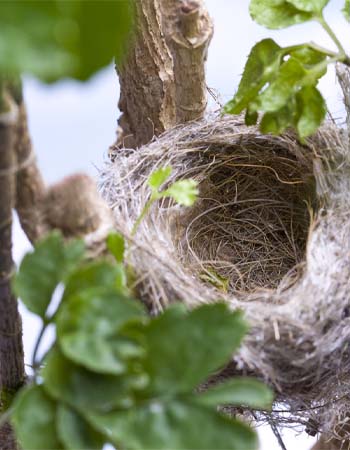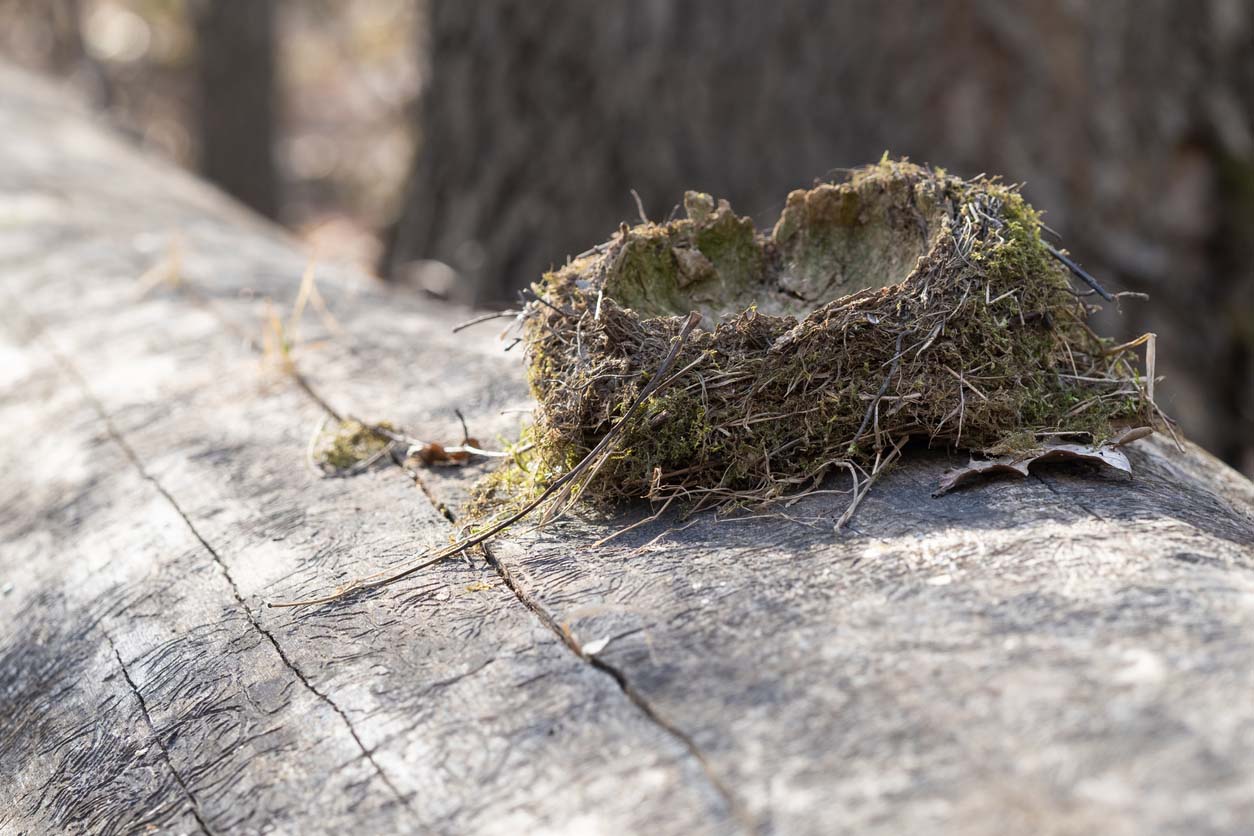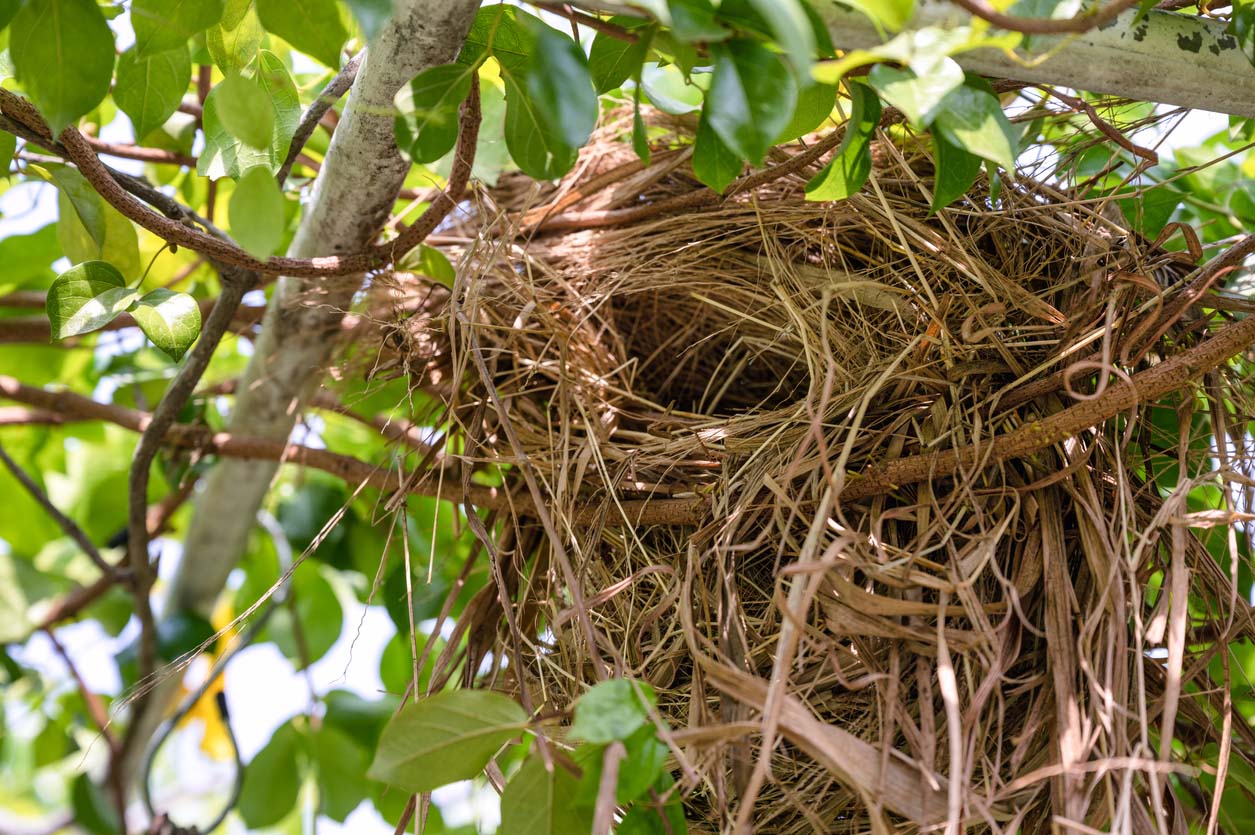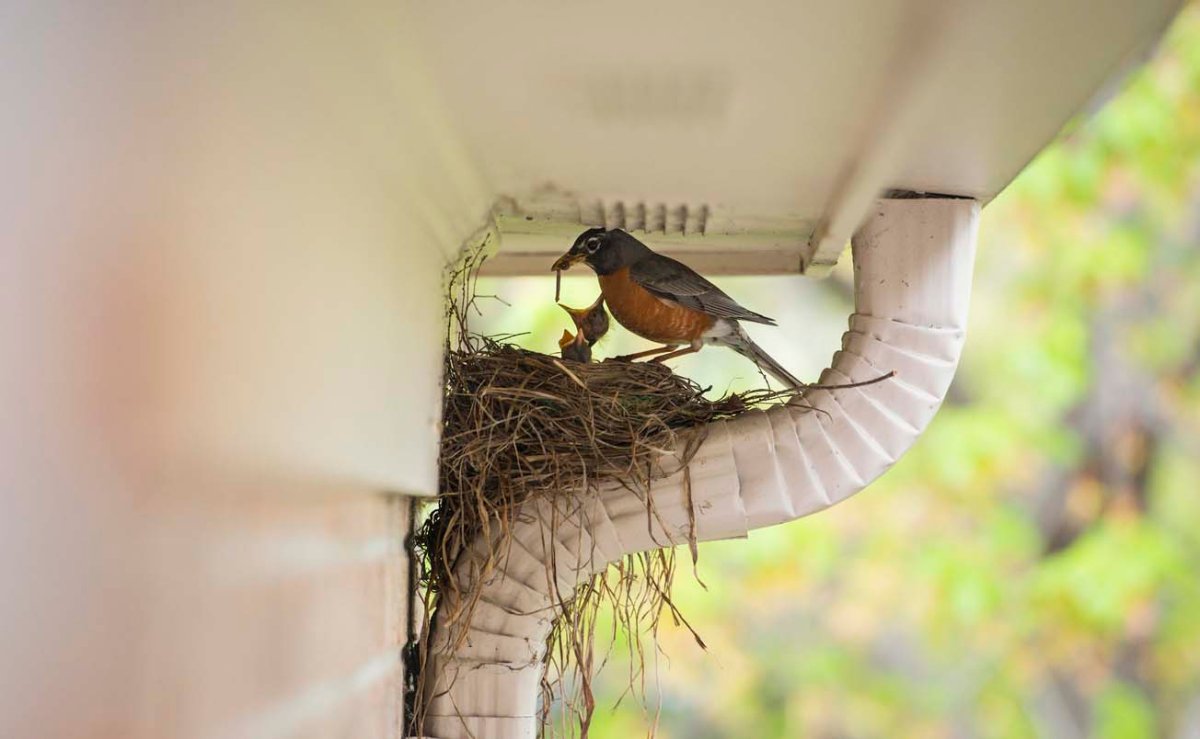We may earn revenue from the products available on this page and participate in affiliate programs. Learn More ›
Can you move a bird’s nest? Well, the answer is not as simple as you may think. The U.S. Fish and Wildlife Service has implemented measures to protect certain bird species. Most bird nests are protected under the Migratory Bird Treaty Act of 1918, making it illegal for civilians to remove or tamper with an active bird’s nest. However, if the nest is abandoned or no eggs have been laid, you can safely relocate or remove the nest. There are some precautionary steps you may want to take, and if the bird nest is difficult to access, it may be a good idea to call in the help of a professional for bird nest removal.
Time required: 1 to 2 hours
Difficulty: Intermediate
Estimated cost: $100 to $2,000
Tools & Materials
Bobvila.com may earn a commission from purchases made through these links.
Before You Begin…

Before attempting bird or bird nest removal, the most important step is to check your local conservation laws and see if the law protects the nest in question. This way, you don’t spend a ton of time and effort learning how to move a bird’s nest that is illegal to tamper with in the first place. Once you’ve determined that the nest can be moved, ensure it’s uninhabited and that nesting season has ended so as not to put a mother or any baby birds in danger. If you have any question about whether or not it’s safe or legal to remove a bird’s nest, it’s a good idea to consult a professional wildlife removal specialist. Professionals will be acquainted with local and national bird nest removal laws and will know the safest way to move bird nests.
Tips for Bird Nest Removal
- Check your local conservation laws to see if removing a bird’s nest in your area is legal.
- Ensure there are no baby birds or unhatched eggs still in the nest.
- Wear gloves and relocate or dispose of the nest away from household pets or other animals.
Safety Considerations
- Before relocating or removing a bird’s nest, be aware of any imminent threats, like other animals or precarious tree branches.
- Wear gloves and long sleeves to ensure you don’t come in contact with parasites, pathogens, or bacteria.
- Sanitize any hard surfaces the nest may have touched.
STEP 1: Check local conservation laws before you attempt to remove a bird’s nest.
Before trying to remove or relocate a bird’s nest, it’s best to check state and national conservation laws. Depending on where you live, there may be specific laws in place that protect the nests and eggs of certain avian species. Generally, it’s illegal to remove or relocate an active bird’s nest. However, if the nest has been abandoned or is inactive, it can be removed. You will need to identify what type of bird built the nest to be sure the nest is inactive. Birds of the same species usually have nests of similar shape, and certain species are more common in areas of high altitude or near the coast. The nest’s materials are another factor that can help identify what type of bird you’re dealing with. If you’re having difficulty identifying the nest, a professional wildlife removal specialist can identify what type of bird built the next and determine if the nest can be moved.
STEP 2: Inspect the nest for any eggs or baby birds.
Without getting too close, it helps to inspect the nest you’re looking to remove to check for existing eggs or baby birds. If unhatched eggs or baby birds are in the nest, it’s best to let the nest be. It’s important to remember that just because there are unhatched eggs in the nest does not mean that those eggs have been abandoned. Some species of birds wait before incubating the eggs, or the adult birds have left for a short period to find food. If possible, check the nest at different points in the day for several days to see if there are any changes.
STEP 3: Identify any imminent threats, and determine a new safe spot for the nest (if relocating it).
While it may generally be illegal to relocate active nests, the exception to this rule is if the birds or eggs are in immediate danger. In this case, you can try to safely relocate the nest or call a professional wildlife removal specialist to move it for you to ensure the birds aren’t harmed and the nest stays intact. Potential predators, dangerous equipment, and broken tree branches can all threaten a nest. Identify a new, safe spot to put the nest that’s not too far from the nest’s original location; birds will generally be able to find the nest if it hasn’t been moved too far away.
It’s also best to relocate the nest quickly and stay away from it after it’s been moved since birds will often steer clear of humans. It’s also a good idea to wear a pair of protective gloves to reduce contact with any bacteria or parasites that may be present in the nest.
Remember that you may need a permit to move a protected species’ nest. In these cases, hiring a wildlife removal specialist can streamline the process and ensure all the proper steps are taken.

STEP 4: Dispose of the nest properly (if not relocating it).
If the nest is uninhabited and doesn’t need to be preserved, you can discard it by putting it in a disposable bag and placing it in a disposal bin located away from your home or yard. To reduce the chance of spreading pathogens, make sure it’s out of the path of household pets or other animals who may prowl the neighborhood. Bird nests can house parasites, ticks, and mites, and bird droppings can contain dangerous bacteria and pathogens.
STEP 4: Sanitize the nest’s previous location.
Once the nest has been properly removed or relocated, it’s wise to sanitize any non-natural surfaces that the nest touched to prevent predators from picking up the scent and to remove any remaining debris or bacteria. You can use a strong disinfectant with paper towels. It’s also important to wear gloves until the cleaning is complete. Once you’ve finished cleaning, throw away the gloves, thoroughly wash your hands, and wash the clothes you were wearing.
STEP 5: Consider professional bird nest removal for nests that are in difficult-to-access areas.
Whether you have a bird’s nest on your house or need to know how to get rid of a bird’s nest on your porch, it can be helpful to hire a wildlife removal specialist for this task. This type of expert will not only know the proper regulations regarding your area and nest removal, but they will also safely remove the nest and clean up any remaining droppings or feathers to prevent new nests from being built.
Professional bird nest removal is also helpful if the nest you’d like to get rid of is in a tricky area, such as a vent, on your roof, or in a gutter. Although it might be tempting to figure out how to remove a bird’s nest yourself, you may do more harm than good if you’re unfamiliar with the species that created the nest. As a bonus, these pros are also helpful if you need to know how to get rid of pigeons, starlings, or other pesky species of birds.

STEP 5: Prevent birds from nesting in unwanted places on your property.
It’s a good idea to put measures in places that prevent birds from nesting around your home in the first place. Any food scraps should be removed, and open trash containers should be sealed tightly. If you have bird feeders or baths, you can relocate them so they’re farther away from your home. You might want to consider installing gutter guards if it’s common for birds to nest in your gutters or downspouts. Wildlife removal specialists may also be able to make any exclusion repairs or put some of the best bird deterrents, like flexible spikes or reflective tape, in strategic places on your home. Preventing birds from nesting on or in your home is easier than dealing with bird-in-vent removal.
Whether you’re dealing with an old, abandoned nest or an active nest that’s under threat, the above steps, along with guidance from a wildlife removal expert, will help you on how to safely and effectively remove a bird nest. Several factors affect whether or not you’re legally able to move a bird’s nest from your home or property, and a skilled wildlife removal technician will know when bird nests can be removed and when they must stay in place.
FAQs
From the best time to remove a bird’s nest to how long nesting lasts, read below for answers to some of the most common questions about bird nest removal.
Q. At what time of year can you remove bird nests?
The best time of year to remove bird nests is after nesting season, which can vary by geographic location and bird species. The farther north you live, the later breeding season will begin.
Q. What happens if you destroy a bird’s nest?
Some birds will abandon their nest if it is destroyed, while other species will rebuild the nest nearby.
Q. Can birds find their nest if it’s moved?
It’s likely that if you move a bird’s nest, it will be hard for the bird to find it since its surroundings are different. If a nest is close to its old location, birds may be able to locate it. It’s best to move a nest after the baby birds have vacated it.
Q. Is it illegal to disturb a bird’s nest?
Many birds and their nests are protected under the Migratory Bird Treaty Act of 1918 (MBTA), which restricts people from destroying or removing a bird’s nest or performing bird removal.
Q. How long does bird nesting last?
Bird nesting can last anywhere from 2 to 10 weeks, depending on the species.
Q. Do mother birds sleep in the nest with their babies?
They do, but only for a few days after they hatch. Unless the temperature is so low that it puts the baby birds in danger, mother birds don’t typically sleep in the same nest.


